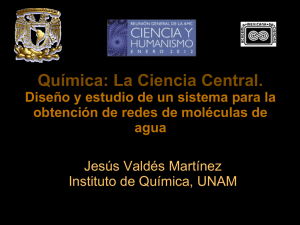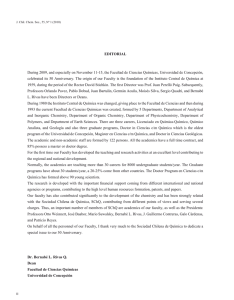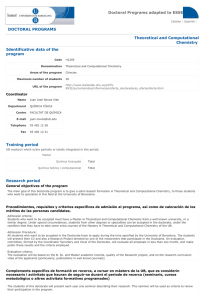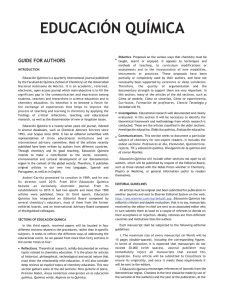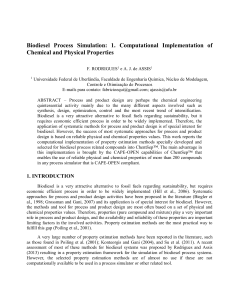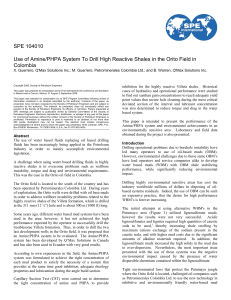synthesis and electronic properties of tris(4-formylbiphenyl-4-yl)
Anuncio
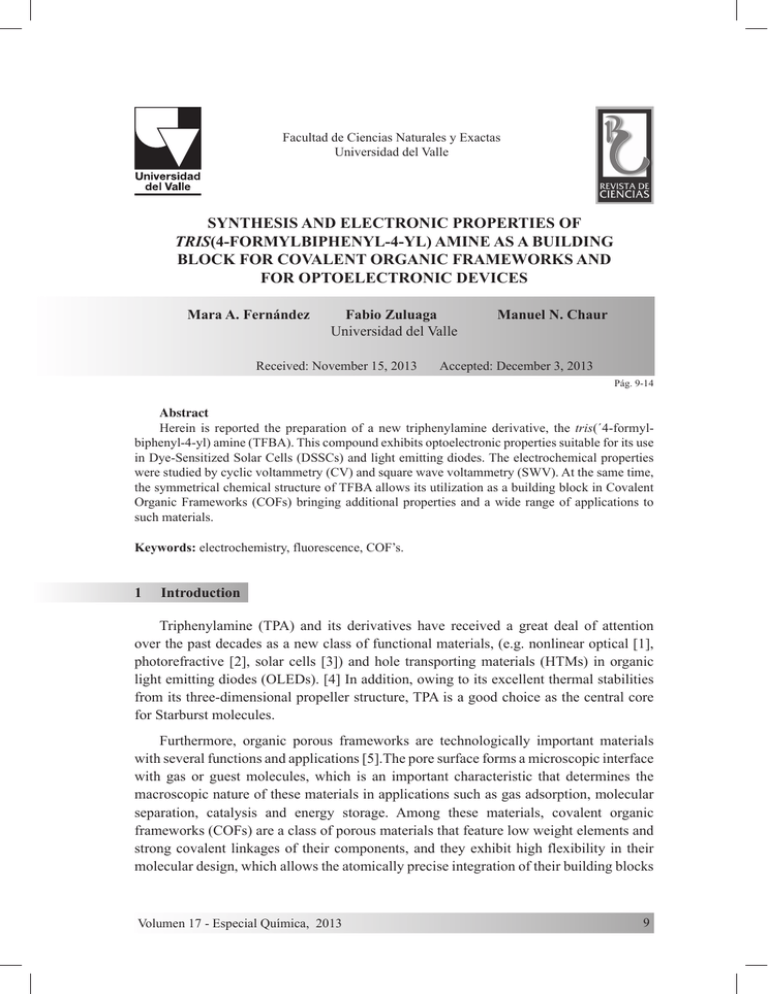
Facultad de Ciencias Naturales y Exactas Universidad del Valle SYNTHESIS AND ELECTRONIC PROPERTIES OF TRIS(4-FORMYLBIPHENYL-4-YL) AMINE AS A BUILDING BLOCK FOR COVALENT ORGANIC FRAMEWORKS AND FOR OPTOELECTRONIC DEVICES Mara A. Fernández Fabio Zuluaga Universidad del Valle Received: November 15, 2013 Manuel N. Chaur Accepted: December 3, 2013 Pág. 9-14 Abstract Herein is reported the preparation of a new triphenylamine derivative, the tris(´4-formylbiphenyl-4-yl) amine (TFBA). This compound exhibits optoelectronic properties suitable for its use in Dye-Sensitized Solar Cells (DSSCs) and light emitting diodes. The electrochemical properties were studied by cyclic voltammetry (CV) and square wave voltammetry (SWV). At the same time, the symmetrical chemical structure of TFBA allows its utilization as a building block in Covalent Organic Frameworks (COFs) bringing additional properties and a wide range of applications to such materials. Keywords: electrochemistry, fluorescence, COF’s. 1 Introduction Triphenylamine (TPA) and its derivatives have received a great deal of attention over the past decades as a new class of functional materials, (e.g. nonlinear optical [1], photorefractive [2], solar cells [3]) and hole transporting materials (HTMs) in organic light emitting diodes (OLEDs). [4] In addition, owing to its excellent thermal stabilities from its three-dimensional propeller structure, TPA is a good choice as the central core for Starburst molecules. Furthermore, organic porous frameworks are technologically important materials with several functions and applications [5].The pore surface forms a microscopic interface with gas or guest molecules, which is an important characteristic that determines the macroscopic nature of these materials in applications such as gas adsorption, molecular separation, catalysis and energy storage. Among these materials, covalent organic frameworks (COFs) are a class of porous materials that feature low weight elements and strong covalent linkages of their components, and they exhibit high flexibility in their molecular design, which allows the atomically precise integration of their building blocks Volumen 17 - Especial Química, 2013 9 Revista de Ciencias M. A. Fernández, F. Zuluaga and M. N. Chaur into porous structures [6]. Despite the availability of a variety of skeletons for COFs, control of the pore surface remains a significant challenge. Additionally, the organic linkers can be selected to have a determined property for a specific purpose. One purpose of our research group is the design of dynamic systems that can respond to both physical and chemical stimuli in a reversible fashion and therefore they can be implemented in several applications at the same time. In this regard the synthesis of tris(´4-formyl-biphenyl-4-yl) amine (TFBA) represents an starting point for the design of photoactive molecules capable of self-assembling and interacting covalently with other building blocks, for instance, for the preparation of novel COFs with not only great absorption properties but also with optoelectronic applications. 2 Results and discussion Scheme 1 shows the synthetic pathway for the preparation of TFBA from TPA. This reaction can be optimized and accelerated by the introduction of microwave radiation (see experimental part). Scheme 1. Synthesis of compounds 1 and 2 from triphenylamine (TPA). The 1H-NMR spectrum of compound 1 shows two doublets at 7.33 and 6.91 ppm (J=8.59 Hz). Each of them integrates for 6 Hs. When going from compound 1 to compound 2, it is observed the appearance of three new signals, a singlet (10.06 ppm, 3H) and two doublets corresponding to the three aldehyde protons and to the inserted aryl moiety respectively (see Figure 1). Figure 1. 1H-NMR (400 MHz, CDCl3) spectra of up) compound 1 and below) compound 2. 10 Synthesis and electronic properties of tris(´4-formyl-biphenyl-4-yl)amine as a building block for... We study the electrochemical properties of compound 2 by using cyclic voltammetry (CV) and osteryoung square wave voltammetry (OSWV). This compound exhibits three reversible oxidation potentials (as determined by CV) at 0.11, 0.44 and 0.80 V (see Figure 2). These potentials contrast with the larger oxidation potential of compound 1 (+0.78 V) [7]. Clearly, compound 2 exhibits a low lying oxidation potential which makes it suitable for molecular electronic applications, DSSCs and OLEDs. Figure 2. Osteryoung square wave voltammetry (OSWV) of compound 2 in 0.1 M n-Bu4NPF6/THF with ferrocene as an internal standard. Scan rate =100 mV/s. UV/Vis absorbance experiments were measured in ethanol (see Figure 3). The substitution of –Br in the TPA framework causes a small shift of 5 nm while compound 2 exhibits a strong absorption peak around 382 nm attributed to the electronic π-π* transition. The large bathochromic shift of 2, compared to TPA, is due to the larger conjugation of compound 2 that lowers the energy level of the π* orbital. The optical band-gaps can be calculated from the spectral onset [8] resulting in 2.44, 2.71 and 1.86 eV for TPA, 1 and 2 respectively. Figure 3. UV-vis spectrum of TPA and compounds 1-2. Concentration of 0.7 mM in ethanol. Volumen 17 - Especial Química, 2013 11 Revista de Ciencias M. A. Fernández, F. Zuluaga and M. N. Chaur The emission spectrum (see Figure 4) of TFBA shows two peaks located around 300 nm and 515 nm, the former of larger intensity. Compounds TPA and 1 exhibit two peaks around 343 and 360 nm. These peaks are of lower intensity compared to TFBA. One possible reason for the large emission intensity in compound 2 compared to TPA, could be the larger conjugation through the carbon framework. Figure 4. Fluorescence spectrum of TPA and compounds 1-2.Concentration of 0.7 mM in ethanol. Excitation wavelength: 285 nm. 3 Conclusions In conclusion, the tris(´4-formyl-biphenyl-4-yl) amine is a symmetrical compound suitable as an organic linker in COFs, besides, its electronic properties such as lower HOMO-LUMO gap than TPA, its low oxidation potential, large emission and absorptions make of compound 2 an excellent candidate for DSSCs and OLEDs applications. Further work is devoted to the synthesis of new TPA derivatives and the rational design and preparation of novel COFs. 4 Methodology The starting materials were purchased from Sigma-Aldrich ´and used without any ´ further purification. FT-IR spectra were taken in a Shimadzu FTIR-8400. 1H and 13C NMR were taken in a 400 MHz Bruker Ultra Shield spectrometer. UV-vis spectra were recorded in a UV-1700 PharmaSpec Shimadzu spectrophotometer. Fluorescence experiments were carried out in a FP-8500 Jasco spectrofluorometer. The synthesis of compound 2, assisted by microwave irradiation, was performed using a Monowave 300 single-mode 12 Synthesis and electronic properties of tris(´4-formyl-biphenyl-4-yl)amine as a building block for... microwave reactor. The reaction temperature was monitored by an internal fiber-optic (FO) temperature probe (ruby thermometer) protected by a borosilicate immersion well inserted directly into the reaction mixture. The reaction time refers to the hold time at the desired set temperature and not to the total irradiation time. Elemental analysis was performed in an analyzer Thermo Finnigan FlashAE1112 CHNS. Cyclic Voltammetry and Osteryoung Square Wave Voltammetry were performed in THF containing 0.1M of N(n-Bu)4PF6 as the supporting electrolyte. The concentration analyzed was about 5.0x10-4 M. A 2 mm diameter glassy carbon disk was used as the working electrode and a platinum wire as the counter electrode. A silver wire served as a pseudo reference electrode. A small amount of ferrocene was added at the end of each experiment and used as a reference for measuring the potentials. Tris(4-bromophenyl)amine (1): Triphenylamine (10 mmol) was dissolved in approximately 10 mL of chloroform after that the solution was cooled down to 0°C and kept under constant stirring . Then 50 mmol of bromine, Br2, was added dropwise in the dark. Once the addition was completed the solution was stirred during 2 hours, time that it took for the reaction to be completed. The product was obtained in 89 % yield after recrystallization from CHCl3-hot ethanol (1:3, v/v). 1H NMR (400 MHz, CDCl3, 25 °C, TMS, δ): 7.33 (d, J=8.59, 6H), 6.91 (d, J=8.59, 6H); 13C NMR (100 MHz, CDCl3, 25 °C, TMS, δ): 146.02, 132.50, 125.60, 116.05. Elemental analysis calculated (%) for C18H12Br3N: C 44.85, H 2.51, N 2.91; found: C 44.81, H 2.47, N 2.93. Tris(´4-formyl-biphenyl-4-yl) amine (2): To a solution of the formerly prepared tris(4-bromophenyl)amine (0.5 mmol) and Pd(dppf)Cl2·CH2Cl2 (0.05 mmol) in toluene (5 mL) was added a solution of 4-formylphenylboronic acid (2.0 mmol) and K2CO3 (2.5 mmol) in methanol (5 mL). The mixture was refluxed during 3 days. The reaction can alternatively be shortened heating the mixture by microwave radiation at 70 °C for 40 minutes. After that the reaction mixture was poured in 100 mL of a saturated solution of NH4Cl. The compound was extracted with dichloromethane (4 x 50 mL) and washed with brine and dried with anhydrous sodium sulfate. After evaporation of the solvent the compound was purified by flash chromatography over silica gel using dichloromethane as eluent. The product was obtained in 74 % yield. 1H NMR (400 MHz, CDCl3, 25 °C, TMS, δ): 10.06 (s, 3H), 7.97 (d, J=8.03, 6H), 7.77 (d, J=8.03, 6H), 7.62 (d, J=8.78, 6H), 7.24-7.33 (m, 6H); 13C NMR (100 MHz, CDCl3, 25 °C, TMS, δ): 191.45, 147.14, 145.97, 134.66, 134.14, 130.05, 128.07, 126.77, and 124.32. Elemental analysis calculated (%) for C18H12Br3N: C 84.00, H 4.88, N 2.51; found: C 83.92, H 4.82, N 2.47. Acknowledgements The authors would like to thank the Banco de la República, the Departamento Administrativo de Ciencia, Tecnología e Innovación (COLCIENCIAS), the Centro en Excelencia en Nuevos Materiales (CENM) and the Vicerrectoría de Investigaciones of the Universidad del Valle for their generous financial support. Volumen 17 - Especial Química, 2013 13 Revista de Ciencias M. A. Fernández, F. Zuluaga and M. N. Chaur References [1] (a) Perry J. W., Barlow S., Ehrlich J. E., Heikal A. A., Hu Z. Y., Lee I. Y. S., Mansour K., Marder S. R., Rockel H., Rumi M., Thayumanavan S. and. WuX. l. (1999). Nonlinear Opt., 21, 225; (b) Roberts R. L., Schwich T., Corkery T. C., Cifuentes M. P., Green K. A., Farmer J. D., Low P. J., Marder T. B., Samoc M. and Humphrey M. G. (2009). Advanced Materials, 21, 2318; (c) Xu B., Fang H., Chen F., Lu H.,He J., Li Y., Chen Q., Sun H. and Tian W. (2009). New Journal of Chemistry, 33, 2457; (d) Yang L., F. Gao, Liu J., Zhong X., Li H. and Zhang S. (2010). Chemistry Letters, 39 (6) 582-583. [2] (a) Lee H. J., Sohn J., Hwang J. and Park S. Y. (2004). Chemistry of Materials, 16 (3) 456-465; (b) Tsutsumi N., Murao T. and Sakai W. (2005). Macromolecules, 38, 7521. [3] (a) Hagberg D. P., Edvinsson T., Marinado T., Boschloo G., Hagfeldt A. and Sun L. (2006) Chem. Commun., 2006, 2245; (b)W. Zhang, Z. Fang, M. Su, M. Saeys and B. Liu (2009) Macromol. Rapid Commun., 30, 1533. [4] (a) C. W. Tang and S. A. VanSlyke (1987). Applied Physics Letters, 51, 913; (b) T. Mori, K. Obata, K. Imaizumi and T. Mizutani (1996). Applied Physics Letters, 69, 3309. [5] A. I. Cooper (2009). Advanced Materials, 21 (12) 1291-1295 [6] A. P. Côté, A.I. Benin, N.W. Ockwig, M.O´keeffe, A.J. Matzger and O. Yaghi, (2005). Science, 310, 1166. [7] A. J. Wain, I. Streeter, M. Thompson, N. Fietkau, L. Drouin, A. J. Fairbanks and R.G. Compton (2006). Journal of Physical Chemistry B, 110 (6) 2681-2691 [8] Band-gaps calculated from the spectral onset; band gap (eV) ≈ 1240/onset (nm). Autor’s address Mara A. Fernández Departamento de Química, Universidad del Valle, Cali - Colombia alefer13@hotmail.com Fabio Zuluaga Departamento de Química, Universidad del Valle, Cali - Colombia hector.zuluaga@correounivalle.edu.co Manuel N. Chaur Departamento de Química, Universidad del Valle, Cali - Colombia manuel.chaur@correounivalle.edu.co 14


